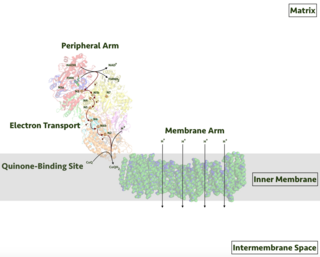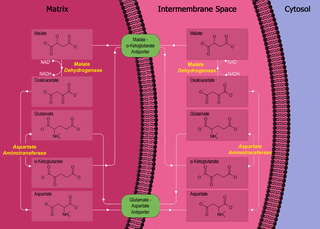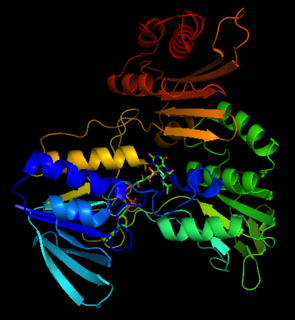Related Research Articles

Adenosine triphosphate (ATP) is an organic compound that provides energy to drive many processes in living cells, such as muscle contraction, nerve impulse propagation, condensate dissolution, and chemical synthesis. Found in all known forms of life, ATP is often referred to as the "molecular unit of currency" of intracellular energy transfer. When consumed in metabolic processes, it converts either to adenosine diphosphate (ADP) or to adenosine monophosphate (AMP). Other processes regenerate ATP. The human body recycles its own body weight equivalent in ATP each day. It is also a precursor to DNA and RNA, and is used as a coenzyme.

The citric acid cycle (CAC)—also known as the Krebs cycle or the TCA cycle —is a series of chemical reactions to release stored energy through the oxidation of acetyl-CoA derived from carbohydrates, fats, and proteins. The Krebs cycle is used by organisms that respire to generate energy, either by anaerobic respiration or aerobic respiration. In addition, the cycle provides precursors of certain amino acids, as well as the reducing agent NADH, that are used in numerous other reactions. Its central importance to many biochemical pathways suggests that it was one of the earliest components of metabolism and may have originated abiogenically. Even though it is branded as a 'cycle', it is not necessary for metabolites to follow only one specific route; at least three alternative segments of the citric acid cycle have been recognized.

Oxidative phosphorylation or electron transport-linked phosphorylation or terminal oxidation is the metabolic pathway in which cells use enzymes to oxidize nutrients, thereby releasing chemical energy in order to produce adenosine triphosphate (ATP). In eukaryotes, this takes place inside mitochondria. Almost all aerobic organisms carry out oxidative phosphorylation. This pathway is so pervasive because it releases more energy than alternative fermentation processes such as anaerobic glycolysis.
A dehydrogenase is an enzyme belonging to the group of oxidoreductases that oxidizes a substrate by reducing an electron acceptor, usually NAD+/NADP+ or a flavin coenzyme such as FAD or FMN. Like all catalysts, they catalyze reverse as well as forward reactions, and in some cases this has physiological significance: for example, alcohol dehydrogenase catalyzes the oxidation of ethanol to acetaldehyde in animals, but in yeast it catalyzes the production of ethanol from acetaldehyde.

An electron transport chain (ETC) is a series of protein complexes and other molecules that transfer electrons from electron donors to electron acceptors via redox reactions (both reduction and oxidation occurring simultaneously) and couples this electron transfer with the transfer of protons (H+ ions) across a membrane. A series of proteins in the inner membrane of mitochondria. The electrons that transferred from NADH and FADH2 to the ETC involves 4 multi-subunit large enzymes complexes and 2 mobile electron carriers. Many of the enzymes in the electron transport chain are membrane-bound.

Respiratory complex I, EC 7.1.1.2 is the first large protein complex of the respiratory chains of many organisms from bacteria to humans. It catalyzes the transfer of electrons from NADH to coenzyme Q10 (CoQ10) and translocates protons across the inner mitochondrial membrane in eukaryotes or the plasma membrane of bacteria.

Succinic acid is a dicarboxylic acid with the chemical formula (CH2)2(CO2H)2. The name derives from Latin succinum, meaning amber. In living organisms, succinic acid takes the form of an anion, succinate, which has multiple biological roles as a metabolic intermediate being converted into fumarate by the enzyme succinate dehydrogenase in complex 2 of the electron transport chain which is involved in making ATP, and as a signaling molecule reflecting the cellular metabolic state. It is marketed as food additive E363. Succinate is generated in mitochondria via the tricarboxylic acid cycle (TCA). Succinate can exit the mitochondrial matrix and function in the cytoplasm as well as the extracellular space, changing gene expression patterns, modulating epigenetic landscape or demonstrating hormone-like signaling. As such, succinate links cellular metabolism, especially ATP formation, to the regulation of cellular function. Dysregulation of succinate synthesis, and therefore ATP synthesis, happens in some genetic mitochondrial diseases, such as Leigh syndrome, and Melas syndrome, and degradation can lead to pathological conditions, such as malignant transformation, inflammation and tissue injury.

Cellular respiration is the process by which biological fuels are oxidised in the presence of an inorganic electron acceptor such as oxygen to produce large amounts of energy, to drive the bulk production of ATP. Cellular respiration may be described as a set of metabolic reactions and processes that take place in the cells of organisms to convert chemical energy from nutrients into adenosine triphosphate (ATP), and then release waste products.

Nicotinamide adenine dinucleotide (NAD) is a coenzyme central to metabolism. Found in all living cells, NAD is called a dinucleotide because it consists of two nucleotides joined through their phosphate groups. One nucleotide contains an adenine nucleobase and the other nicotinamide. NAD exists in two forms: an oxidized and reduced form, abbreviated as NAD+ and NADH (H for hydrogen), respectively.
Reperfusion injury, sometimes called ischemia-reperfusion injury (IRI) or reoxygenation injury, is the tissue damage caused when blood supply returns to tissue after a period of ischemia or lack of oxygen. The absence of oxygen and nutrients from blood during the ischemic period creates a condition in which the restoration of circulation results in inflammation and oxidative damage through the induction of oxidative stress rather than restoration of normal function.

Nicotinamide adenine dinucleotide phosphate, abbreviated NADP+ or, in older notation, TPN (triphosphopyridine nucleotide), is a cofactor used in anabolic reactions, such as the Calvin cycle and lipid and nucleic acid syntheses, which require NADPH as a reducing agent ('hydrogen source'). It is used by all forms of cellular life.

Succinate dehydrogenase (SDH) or succinate-coenzyme Q reductase (SQR) or respiratory complex II is an enzyme complex, found in many bacterial cells and in the inner mitochondrial membrane of eukaryotes. It is the only enzyme that participates in both the citric acid cycle and the electron transport chain. Histochemical analysis showing high succinate dehydrogenase in muscle demonstrates high mitochondrial content and high oxidative potential.

In the mitochondrion, the matrix is the space within the inner membrane. The word "matrix" stems from the fact that this space is viscous, compared to the relatively aqueous cytoplasm. The mitochondrial matrix contains the mitochondrial DNA, ribosomes, soluble enzymes, small organic molecules, nucleotide cofactors, and inorganic ions.[1] The enzymes in the matrix facilitate reactions responsible for the production of ATP, such as the citric acid cycle, oxidative phosphorylation, oxidation of pyruvate, and the beta oxidation of fatty acids.

In biochemistry, flavin adenine dinucleotide (FAD) is a redox-active coenzyme associated with various proteins, which is involved with several enzymatic reactions in metabolism. A flavoprotein is a protein that contains a flavin group, which may be in the form of FAD or flavin mononucleotide (FMN). Many flavoproteins are known: components of the succinate dehydrogenase complex, α-ketoglutarate dehydrogenase, and a component of the pyruvate dehydrogenase complex.

Flavin mononucleotide (FMN), or riboflavin-5′-phosphate, is a biomolecule produced from riboflavin (vitamin B2) by the enzyme riboflavin kinase and functions as the prosthetic group of various oxidoreductases, including NADH dehydrogenase, as well as cofactor in biological blue-light photo receptors. During the catalytic cycle, a reversible interconversion of the oxidized (FMN), semiquinone (FMNH•), and reduced (FMNH2) forms occurs in the various oxidoreductases. FMN is a stronger oxidizing agent than NAD and is particularly useful because it can take part in both one- and two-electron transfers. In its role as blue-light photo receptor, (oxidized) FMN stands out from the 'conventional' photo receptors as the signaling state and not an E/Z isomerization.
Substrate-level phosphorylation is a metabolism reaction that results in the production of ATP or GTP by the transfer of a phosphate group from a substrate directly to ADP or GDP. Transferring from a higher energy (whether phosphate group attached or not) into a lower energy product. This process uses some of the released chemical energy, the Gibbs free energy, to transfer a phosphoryl (PO3) group to ADP or GDP from another phosphorylated compound. Occurs in glycolysis and in the citric acid cycle.

The malate-aspartate shuttle is a biochemical system for translocating electrons produced during glycolysis across the semipermeable inner membrane of the mitochondrion for oxidative phosphorylation in eukaryotes. These electrons enter the electron transport chain of the mitochondria via reduction equivalents to generate ATP. The shuttle system is required because the mitochondrial inner membrane is impermeable to NADH, the primary reducing equivalent of the electron transport chain. To circumvent this, malate carries the reducing equivalents across the membrane.

Glycerol-3-phosphate dehydrogenase (GPDH) is an enzyme that catalyzes the reversible redox conversion of dihydroxyacetone phosphate to sn-glycerol 3-phosphate.

In enzymology, a NADH peroxidase (EC 1.11.1.1) is an enzyme that catalyzes the chemical reaction
The lactate shuttle hypothesis describes the movement of lactate intracellularly and intercellularly. The hypothesis is based on the observation that lactate is formed and utilized continuously in diverse cells under both anaerobic and aerobic conditions. Further, lactate produced at sites with high rates of glycolysis and glycogenolysis can be shuttled to adjacent or remote sites including heart or skeletal muscles where the lactate can be used as a gluconeogenic precursor or substrate for oxidation. They hypothesis was proposed by professor George Brooks of the University of California at Berkeley.
References
- ↑ Kim, B. H.; Gadd, G. M. (2008). Bacterial Physiology and Metabolism . Cambridge, UK: Cambridge University Press.
- ↑ Chance, Britton; Hollunger, Gunnar (March 1960). "Energy-Linked Reduction of Mitochondrial Pyridine Nucleotide". Nature. 185 (4714): 666–672. Bibcode:1960Natur.185..666C. doi:10.1038/185666a0. PMID 13809106. S2CID 4267386.
- ↑ Niatsetskaya, Z. V.; Sosunov, S. A.; Matsiukevich, D.; Utkina-Sosunova, I. V.; Ratner, V. I.; Starkov, A. A.; Ten, V. S. (2012-02-29). "The Oxygen Free Radicals Originating from Mitochondrial Complex I Contribute to Oxidative Brain Injury Following Hypoxia-Ischemia in Neonatal Mice". Journal of Neuroscience. 32 (9): 3235–3244. doi:10.1523/JNEUROSCI.6303-11.2012. PMC 3296485 . PMID 22378894.
- ↑ Chouchani, Edward T.; Pell, Victoria R.; Gaude, Edoardo; Aksentijević, Dunja; Sundier, Stephanie Y.; Robb, Ellen L.; Logan, Angela; Nadtochiy, Sergiy M.; Ord, Emily N. J.; Smith, Anthony C.; Eyassu, Filmon; Shirley, Rachel; Hu, Chou-Hui; Dare, Anna J.; James, Andrew M.; Rogatti, Sebastian; Hartley, Richard C.; Eaton, Simon; Costa, Ana S. H.; Brookes, Paul S.; Davidson, Sean M.; Duchen, Michael R.; Saeb-Parsy, Kourosh; Shattock, Michael J.; Robinson, Alan J.; Work, Lorraine M.; Frezza, Christian; Krieg, Thomas; Murphy, Michael P. (2014-11-20). "Ischaemic accumulation of succinate controls reperfusion injury through mitochondrial ROS". Nature. 515 (7527): 431–435. Bibcode:2014Natur.515..431C. doi:10.1038/nature13909. PMC 4255242 . PMID 25383517.
- ↑ Sahni, PV; Zhang, J; Sosunov, S; Galkin, A; Niatsetskaya, Z; Starkov, A; Brookes, PS; Ten, VS (2018). "Krebs cycle metabolites and preferential succinate oxidation following neonatal hypoxic-ischemic brain injury in mice". Pediatric Research. 83 (2): 491–497. doi:10.1038/pr.2017.277. PMC 5866163 . PMID 29211056.
- ↑ Pisarenko, O; Studneva, I; Khlopkov, V (1987). "Metabolism of the tricarboxylic acid cycle intermediates and related amino acids in ischemic guinea pig heart". Biomedica Biochimica Acta. 46 (8–9): 568–571. PMID 2893608.
- ↑ Andreyev, A. Yu.; Kushnareva, Yu. E.; Starkov, A. A. (2005). "Mitochondrial metabolism of reactive oxygen species". Biochemistry (Moscow). 70 (2): 200–214. doi:10.1007/s10541-005-0102-7. PMID 15807660. S2CID 17871230.
- ↑ Quinlan, Casey L.; Perevoshchikova, Irina V.; Hey-Mogensen, Martin; Orr, Adam L.; Brand, Martin D. (2013). "Sites of reactive oxygen species generation by mitochondria oxidizing different substrates". Redox Biology. 1 (1): 304–312. doi:10.1016/j.redox.2013.04.005. PMC 3757699 . PMID 24024165.
- ↑ Stepanova, Anna; Kahl, Anja; Konrad, Csaba; Ten, Vadim; Starkov, Anatoly S; Galkin, Alexander (December 2017). "Reverse electron transfer results in a loss of flavin from mitochondrial complex I: Potential mechanism for brain ischemia reperfusion injury". Journal of Cerebral Blood Flow & Metabolism. 37 (12): 3649–3658. doi:10.1177/0271678X17730242. PMC 5718331 . PMID 28914132.